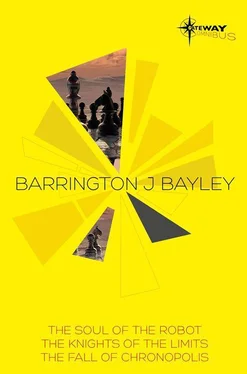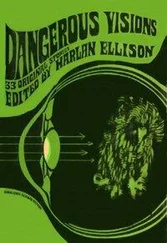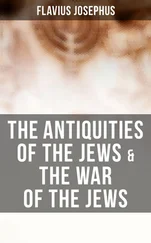About two years ago the old itch had come upon him again.
Did he, or did he not, exist?
For five years he had been able to forget the tormenting enigma. It had returned to him almost by accident, when a raid on the premises of a religious sect, suspected of assisting Borgor, had yielded a find of old and rare books.
He rose and stepped to a bookcase, taking from it the volume that had first returned his mind to the hunt. This small book, bound in red leather which had become soft and worn with age, contained a number of short dissertations. He opened it. The first essay was entitled:
THE SEARCH FOR THE TOTALITRON
Much is known of the class of fundamental particles which exist within the universe at relative locations or points and which are responsible for the transfer of energy from place to place, i.e. between one another. Theory strongly predicts, however, that particles comprise only one half of the picture. The universe also exists as a whole, or totality, and to maintain this totality there must exist a range of ‘totalistic energies’ and, associated with them, their corresponding ‘particles’ or, particle being a misnomer in this case, totalitrons .
The particle is the form of particularity; the totalitron of totality. Whereas a particle can be described as a size and a vector within space, with other typical characteristics, a totalitron is omnipresent throughout the whole of space. It can be said that the functions of particle and totalitron are complementary and inevitable: there can be no part without the whole, and no whole without parts.
Types of totalitron
Since particles and totalitrons are opposite in nature and therefore mirror one another, so to speak, it is anticipated that there are as many types of totalitron as there are types of particle. Whether the number of totalitrons equals the aggregate number of particles is uncertain. The theory does state, however, that there is more than one totalitron of each type, and it is generally believed that totalitrons are not significantly less numerous than particles.
Properties of totalitrons
Again on theoretical grounds, totalitrons are held to possess properties corresponding to the mass, charge, spin and strangeness exhibited by particles, though it is far from clear how ‘totalitron charge’, for instance, would manifest itself. ‘Spatiability’ and ‘chronicity’ have been suggested as totalitron properties, with a property called ‘total spin’ sometimes being added. A totalitron might for example be said to possess a chronicity of 1, a spatiability of 1, and a spin of ½.
Interaction between totalitrons
Comprising as they do the structure of totality taken without relation to any division of parts, the exchanges between totalitrons must differ in essence from the energy exchanges between particles. It is anticipated however that when enough is known about them a systemic pattern will emerge bearing some resemblance to the reactions between particles, or rather to the inverse of those reactions.
Interaction between particles and totalitrons
Particles and totalitrons are of course uniquely related to one another. Without totalitrons there could be no total universe and it would be empty of any specific locations and of material without particles. The two classes of ‘basic entity’ must, then, interact in some undefined way that keeps their relationship stable.
Investigating the totalitron
Research into the totalitron has to date been scanty. Producing a ‘totalitron beam’ presents difficulties since each totalitron occupies the whole of universal space. Nevertheless an attempt at intercepting ‘an omnipresent totalitron beam’ has been claimed as successful. In this experiment the monks of the Scientific Academy sat in a circle of twenty-four, each intoning in turn the mantra OM…
After that the dissertation degenerated into what Jasperodus could only think of as gibberish. Yet he could recall with what excitement he had initially read the paper.
It ended with a drawing of a curious symbol consisting of two interlocking triangles, one inverted in relation to the other, representing the interaction of particle and totalitron, of the part and the whole, of the microcosm and the macrocosm. Could it be, he had wondered, that the totalitron was the stuff of consciousness? Of the soul ? He already knew that consciousness could not be constructed out of matter, that is out of interactions between particles. But did not the totalitron possess exactly those properties specified in the consciousness equations? Indivisibility? Lack of differentiated parts? With fresh hope Jasperodus had launched into a study of what loosely was known as the occult. He had read ancient and arcane books, he had sought out magical societies, he had talked at length with self-styled adepts. But in the end he had been disappointed. He had decided, after investigating it all, that the ideation of the occult was little more than hot air and smoke. The ‘science’ that sometimes was associated with it – though on occasion fascinating and well thought-out – was pseudo-science, deficient in its appreciation of reality.
Still, the urge to know the truth about himself had been piqued afresh. He had entered on new projects. Chief of these was an attempt to duplicate himself. Hiring the best robotician he could find, he had manufactured a robot that as near as could be judged was a complete Jasperodus replica. The crucial part – the brain – had been the most difficult, since there was a limit to how exhaustively his own brain could be examined. He and the robotician had also devised what they hoped was a duplication of the ‘fictitious self-image’ with which he was inflicted.
Upon activation he had spent long periods in the company of his replica. He had asked him if he was conscious: Jasperodus 2 invariably answered that he was. They had discoursed at length and in depth upon countless subjects. He had given Jasperodus 2 boundless opportunities both for study and for experience. He had treated him like the son he was.
And then, inexorably, terribly, he had come to see that Jasperodus 2, whatever he himself might avow, was dead. Clever, yes; intelligent, yes; but a machine, not a person.
His son now worked on the planning staff, where he proved more than adequate, though not brilliant. He lacked some of the fire of the original; Jasperodus attributed this to the indeterminacy factor that had been built into the moment of activation. An advanced robot’s final disposition was usually left partly to chance.
One more avenue was open to Jasperodus. Aristos Lyos, master robotician, teacher to his own maker, the greatest robot expert of all time, was surely the supreme authority on the subject. Whatever Jasperodus’ father had done, he learned it from Lyos. If he could find him his existential status – or the feasibility of changing it – could be determined for good and all and he would be rid of this nagging doubt.
Soberly he closed the book and replaced it on the shelf. He sat quietly for a few minutes longer, as though fearing the coming encounter, then left for the flying stables where his personal aircraft was kept. The guide, a small nervous man, was already waiting.
For two hours they flew south. Jasperodus headed for Shang, then on the guide’s instructions turned westward along the coast. Presently the guide indicated, on a promontory overlooking the sea, a modest but graceful villa of sparkling white stone. Jasperodus chanced to find a stretch of level ground and made a bumpy landing.
Leaving the guide in the plane he trudged towards the villa, which as he neared it took on the appearance of a structure carved out of salt, so pure and crystalline white was the stone. None of the walls presented a flat surface but all were rounded, following a pattern of spherical and ovoidal curves. The roofs, which were piled at various heights, resembled the caps of toadstools.
Читать дальше












